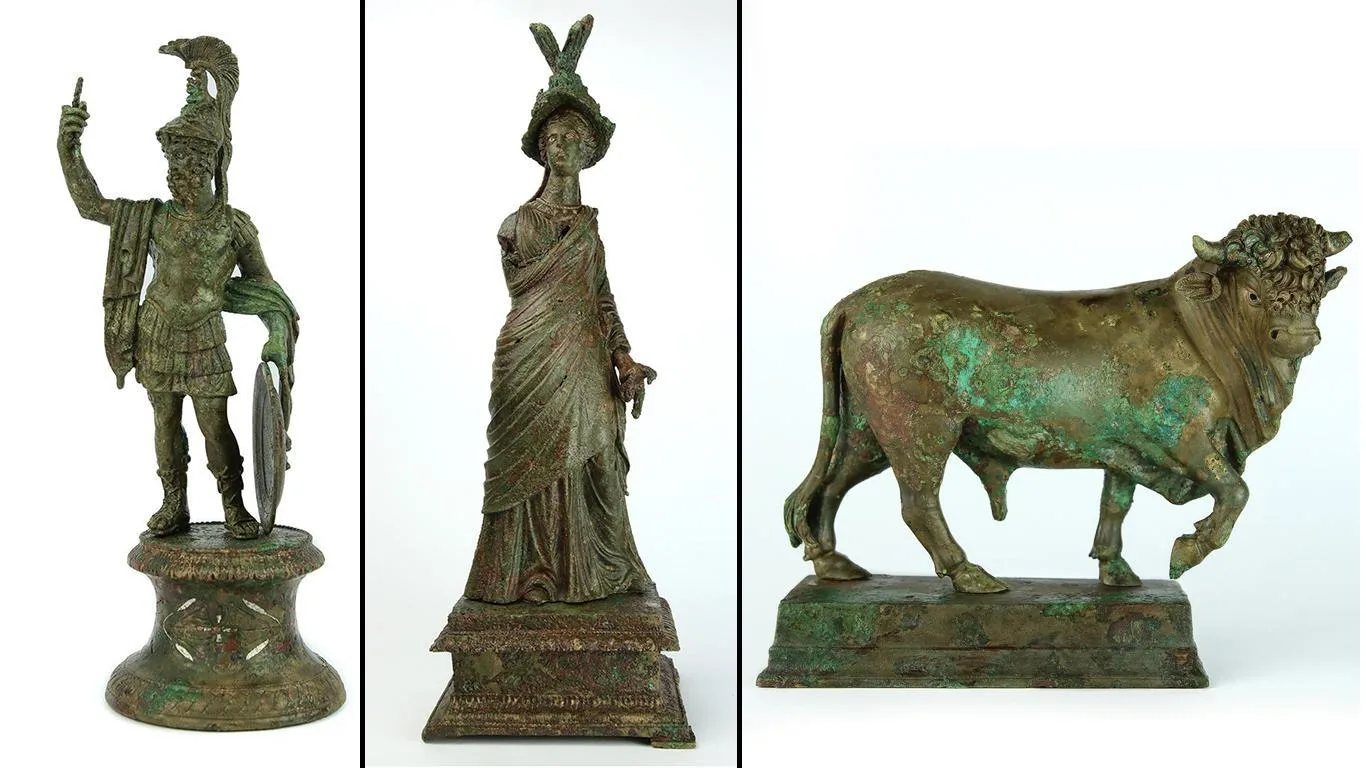
10 December 2024
Archaeologists from France's National Institute of Preventative Archaeological Research (INRAP) have unearthed an extraordinary Roman domus dating back to the 2nd century CE on the outskirts of ancient Durocortorum, now modern-day Reims. The discovery includes three exquisite bronze statuettes and fragments of frescoes, highlighting the cultural sophistication and wealth of the provincial elite during the Roman era.
Durocortorum was a prominent urban center in Roman Gaul, serving as the provincial capital of Gallia Belgica. At its height, the city followed a Roman urban grid centered on a bustling forum, the nucleus of political and religious activity. However, areas farther from the forum, such as the western fringes where the domus was discovered, remain less understood. This residence, over a kilometer from the forum and situated near the Vesle River, showcases the wealth and artistry of its owners despite its peripheral location.
The domus featured an imposing facade with two grand pillars and walls adorned with frescoes. Among these were depictions of life-sized figures, known as megalographies. Notably, fragments of the frescoes referenced the mythological tale of Achilles and Deidamia, a narrative tied to the Trojan War.
This scene, prized in Roman culture, has only been documented in four other locations: Aquileia, Pompeii, Rome, and now Reims. "Its presence in Reims highlights the cultural connections between this provincial capital and the Roman metropolis," stated INRAP.
Amidst the debris of what appears to have been a fire, three bronze statuettes were uncovered, each remarkable for its craftsmanship and symbolic significance:
Mars: This 18-centimeter-tall depiction of the Roman god of war is adorned with intricate details. Its silver-inlaid eyes lend it a lifelike gaze, while its breastplate features a Medusa head and a relief of the Capitoline wolf nursing Romulus and Remus, iconic symbols of Rome. The statuette rests on a circular base adorned with floral motifs in silver and copper.
The Bull: Measuring 16.7 cm in width and 11.6 cm in height, the bull statuette displays a naturalistic expression, emphasized by its silver-highlighted eyes. It rests on a rectangular base that enhances its stability and showcases the artist's skill.
Female Figure: Standing 30.7 cm tall, this statuette is perhaps the most enigmatic. Initially identified as a goddess, the figure combines diverse mythological elements. She wears a helmet adorned with a sphinx and a crenelated crown, possibly an allegory of a city. Slots on her back suggest the former presence of wings. She wields Hercules' club entwined with a serpent, resting on the Nemean Lion's skin, merging various Roman mythological motifs.
> Archaeologists Uncover Opulent Roman Artifacts in Reims
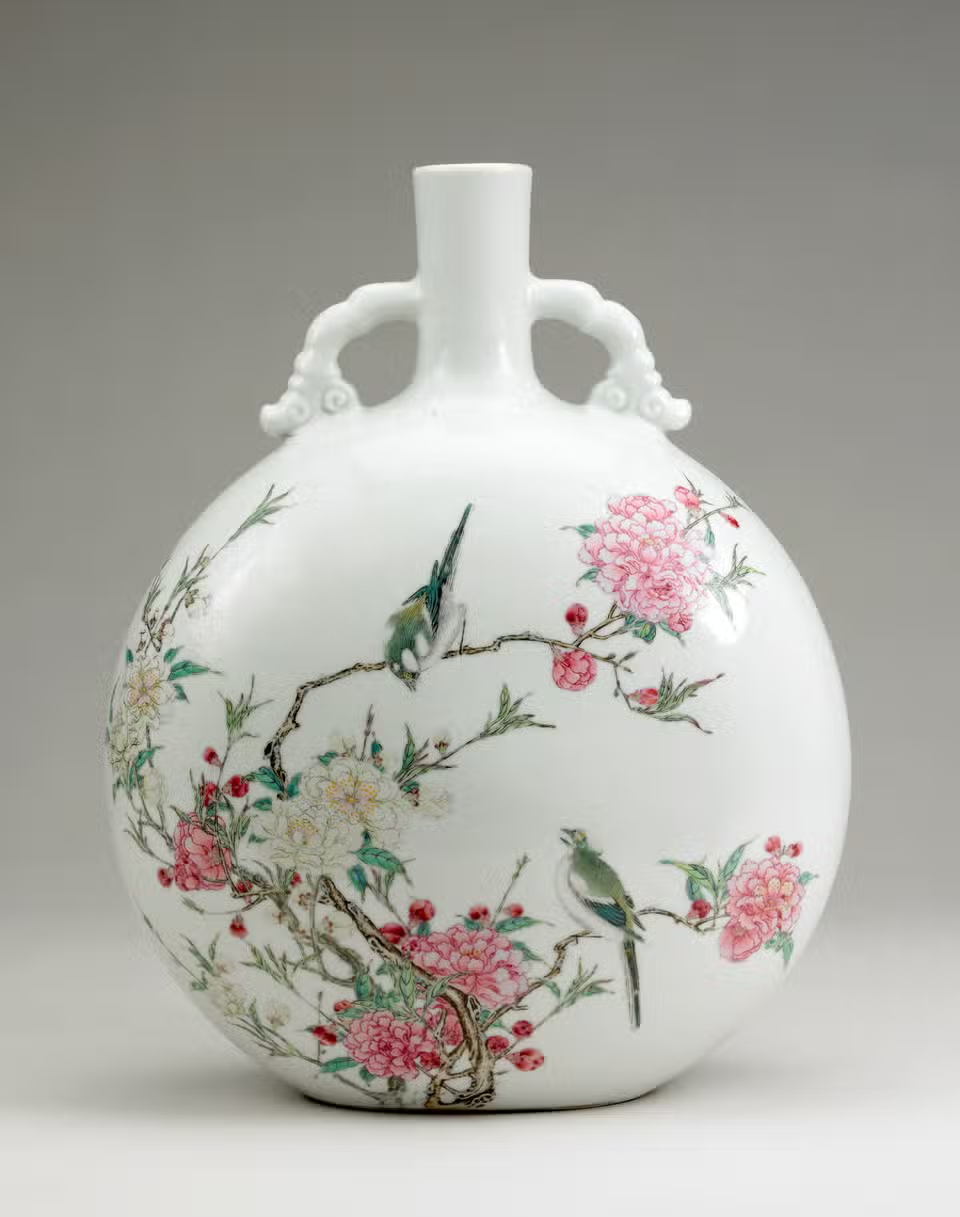
24 November 2024
The British Museum is to be given Chinese ceramics worth £1bn in what is believed to be the highest-value gift received by a UK museum
The addition of the items from the Sir Percival David Foundation will also make the museum's stock of the antiques one of the most important outside of the Chinese-speaking world. Some of the donated items date from the third to 20th Century.
Museum director Dr Nicholas Cullinan said the objects would offer visitors and researchers "the incredible opportunity to study and enjoy the very best examples of Chinese craftsmanship anywhere in existence."
The 1,700 items, which have already been on long-term loan to the museum since 2009, were collected by Indian-born British businessman Sir Percival David, who lived from 1892 to 1964. He collected the items - mostly of imperial quality - in Europe, Japan, Hong Kong and China.
Items in the collection include vases from 1351 which revolutionised the dating for blue and white ceramics with their discovery, as well as a cup decorated with a chicken that was used to serve wine for the Chenghua emperor in the 1400s.
The foundation said Sir Percival wanted his private collection to be on public display to inspire and educate future generations
> British Museum given £1bn of Chinese ceramics
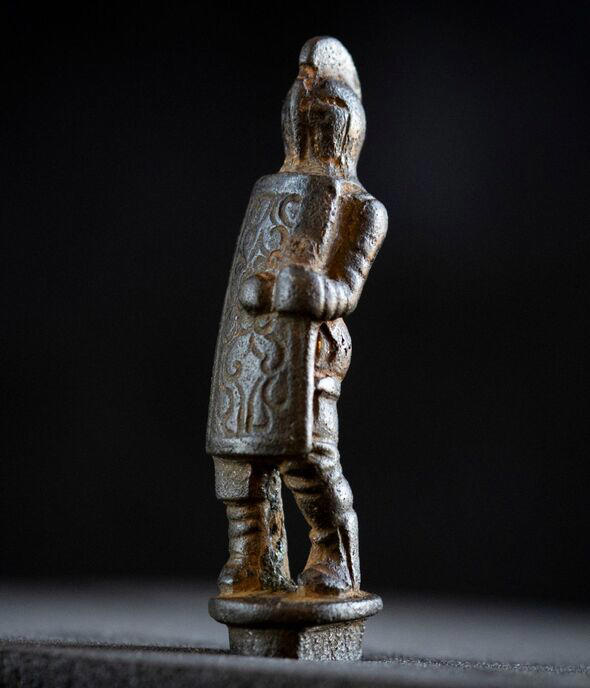
16 November 2024
A rare Roman knife handle was discovered in a river near Hadrian's Wall in Northumberland, giving further proof to the existence of gladiators in the UK.
The handle crafted from copper alloy is intricately cast in the shape of a gladiator, complete with a sword, helmet, and shield - a distinctive and uncommon roman souvineer in the UK. This fascinating artifact was discovered in the river near Corbridge Roman Town, once a bustling Roman town.
Dr Frances McIntosh, English Heritage's collections curator for Hadrian's Wall and the North East, said: "It is rare to find a piece of gladiator memorabilia in Britain and to find such a well preserved and interesting piece is particularly remarkable. "This beautifully made knife handle is a testament to how pervasive this celebrity culture was, reaching all the way to Hadrian's Wall at the very edge of the Roman Empire."
English Heritage plans to display the knife at Corbridge Roman Town in 2025, alongside other finds from the River Tyne. The secutor figurine is left-handed, which would have been considered unlucky at the time, meaning it could represent a specific gladiator. Some were taught to fight left-handed, perhaps to gain advantage over their opponents. McIntosh explained gladiators sometimes became celebrities while being enslaved, inspiring the creation of memorabilia, such as decorated ceramics and glass cups, and figurines.
English Heritage's extensive national collection showcases other discoveries, such as a Samian bowl found at Richborough Roman Fort and Amphitheatre in Kent, which depicts various fight scenes. One scene shows a gladiator standing with arm and shield aloft with their defeated opponent kneeling before them. The collection also includes glass vials, found at Wroxeter Roman City in Shropshire and Aldborough Roman Site in Yorkshire, which would have held perfume and saffron-infused water to sprinkle on spectators.
A piece of glass painted with a leopard was also found at Corbridge, and after analysis, it's thought to depict part of an animal hunt, known as a venatio, which was a key element of the Roman games alongside gladiator fights.
> Archaeology breakthrough that proves amazing Roman gladiator link in Britain
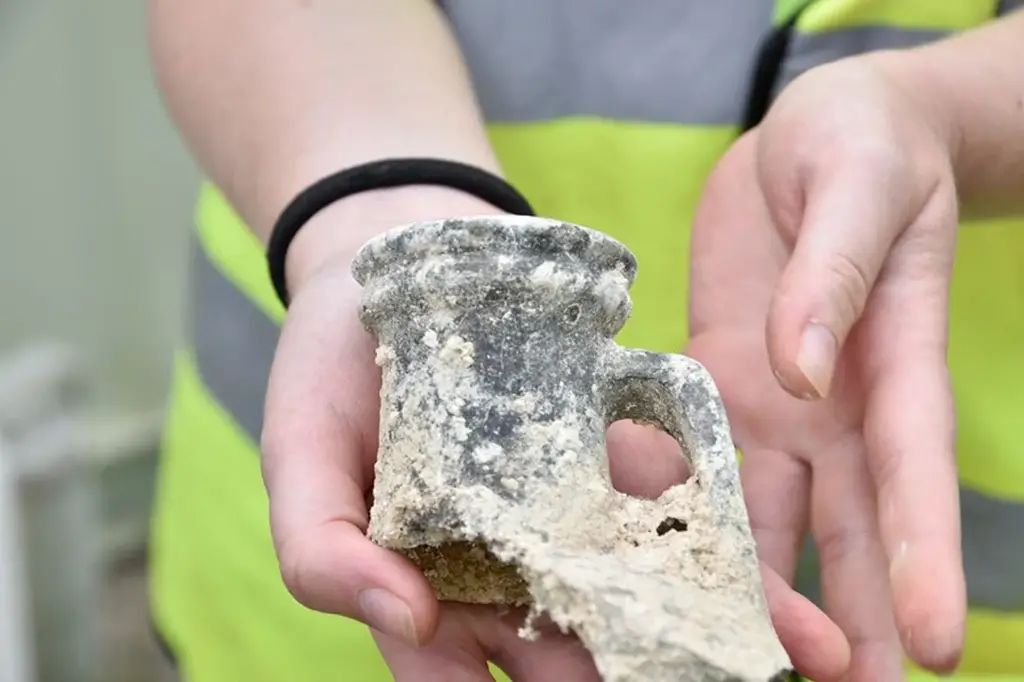
2 July 2024
Archaeologists from Bournemouth University (BU) have been excavating several Iron Age settlements near the village of Winterborne Kingston in southern England. The team has uncovered 2,000-year-old burial pits containing the skeletal remains of ancient Britons. Alongside the burials, Roman-style wine cups and flagons were found, offering a unique insight into how the Britons adapted to life following the Roman invasion of AD 43.
The drinking vessels appear Roman in form, however, they are local copies of Mediterranean style vessels manufactured in nearby Poole harbour. According to the researchers, this suggests that Mediterranean alcohol had already become a popular addition in the societal drinking habits of ancient Britons. "They are made from a local fabric by a local potter, but they are very much in a Roman style and not something we had found in local traditions before," said Kerry Barras, a visiting researcher at Bournemouth University.
Dr Miles Russell, Principal Academic in Archaeology at Bournemouth University, said: "It's all very well learning about the Roman legions and their conquests, but we wanted to find the farmsteads and burials that tell us what life was like for ordinary Britons and what happened to them at the time - did they become part of the wider empire, did they resist, or did they carry on living as they had always done? So finding a site like this was critical."
> Excavation uncovers traces of how ancient Britons adapted to the Roman conquest
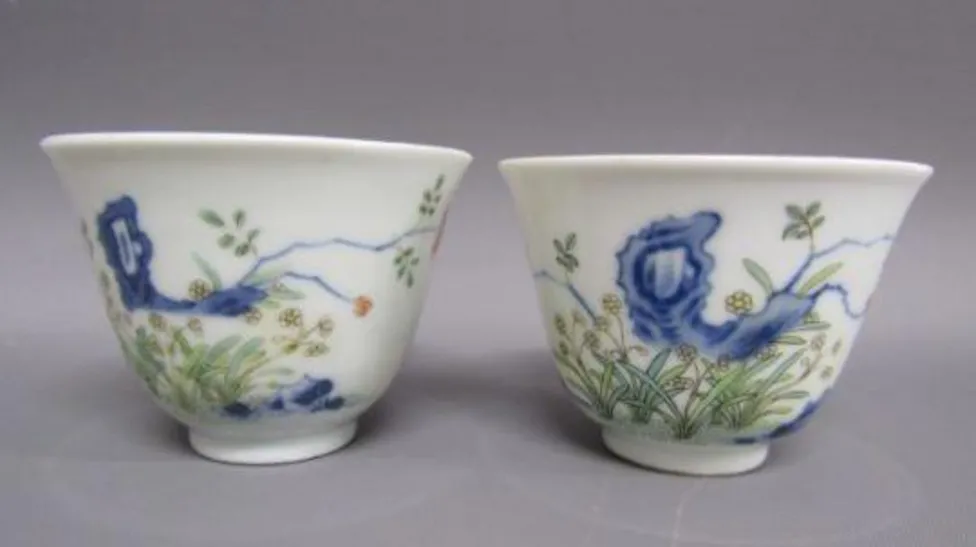
2 July 2024
A box of Chinese porcelain left in an attic in Lincolnshire for more than two decades sold for £162,000 at auction
The collection, which had been labelled "broken porcelain", had sat in a loft in Benniworth, near Louth, before owner Gill Stewart took it to an auctioneers. Ms Stewart had been left it by her grandfather, who had been stationed in China before World War One. She said she was "completely bamboozled" by the price the collection fetched at auction. She said that when her grandparents died, she was given the box with its "broken porcelain" label. "I brought it up to Lincolnshire [in 2002] and since then it's just lived in the attic," she said. "Every time I went up to get the Christmas decorations, I thought I must do something with that box".
Auctioneer James Laverack, from John Taylors Auction Rooms in Louth, which sold the lots, said the items were "quite unassuming, really". "It's the sort of stuff you would hear about people finding in charity shops or carboots," he said. "Most people wouldn't think they're worth more than a pound or two, but they're rare, highly collectable and therefore highly valuable."
> Box full of 'broken porcelain' sells for more than £160,000
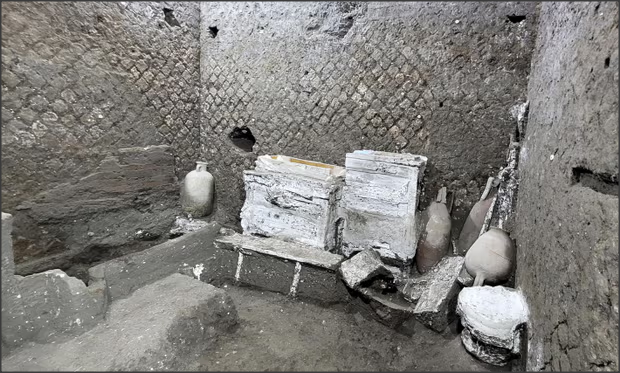
10 September 2023
Archaeologists have discovered a small bedroom in a Roman villa near Pompeii that was almost certainly used by slaves, throwing light on their lowly status in the ancient world, Italy's culture ministry said.
The room was found at the Civita Giuliana villa, some 600 metres (2,000ft) north of the walls of Pompeii, which was wiped out by a volcanic eruption of Mount Vesuvius nearly 2,000 years ago. It contained two beds, only one of which had a mattress, two small cabinets and a series of urns and ceramic containers, in which the remains of two mice and a rat were found.
"These details once again underline the conditions of precarity and poor hygiene in which the lower echelons of society lived during that time," the culture ministry said in its statement. There were no traces of grates, locks, or chains to restrain the room's inhabitants. "It seems that control was primarily exerted through the internal organisation of servitude, rather than physical barriers and restraints," said Gabriel Zuchtriegel, the director of the Archaeological Park of Pompeii.
Excavations at the Civita Giuliana villa were carried out in 1907-1908, and again from 2017 when police realised the site was being plundered by illegal diggers. Archaeologists said part of one of the beds had been destroyed by a tunnel used by robbers to access another part of the villa.
Mount Vesuvius exploded in AD 79, killing thousands of Romans who had no idea they were living beneath one of Europe's biggest volcanoes. The eruption buried the city in a thick layer of ash, preserving many of its residents and buildings.
The site has seen a burst of recent archaeological activity aimed at halting years of decay and neglect, largely thanks to a 105m euro (90m pound) EU-funded project. Gennaro Sangiuliano, the culture minister, said on Sunday that conservation and research efforts would continue. "What we are learning about the material conditions and social organisation of that era opens up new horizons for historical and archaeological studies," he said.
> Bedroom 'used by slaves' found by archaeologists near Pompeii

27 August 2023
A unique artifact discovered at the Roman fort of Vindolanda may have been used as a device during sex rather than as a good luck symbol, archaeologists suggest. The wooden object was initially thought to be a darning tool since it had been found alongside dozens of shoes and dress accessories, as well as other small tools and craft waste products such as leather off-cuts and worked antler, that were discarded in the 2nd century fort ditch. But new analysis by experts at Newcastle University and University College Dublin has shown it to be the first known example of a disembodied phallus made of wood recovered anywhere in the Roman world.
Phalli ussion paper published in the journal Antiquity, the team explore three possible explanations for the phallus' purpose. One of these is that the life-sized object was used as a sexual implement. Another possibility, the team say, is that the object may have been used as a pestle - either for culinary purposes or to grind ingredients for cosmetics or medicinal treatments. Its size may have made it easy to be hand-held while its shape would have imbued the food or ingredients being prepared with perceived magical properties.
The third possible function was that the phallus may have been slotted into a statue which passers-by would touch for good luck or to absorb or activate protection from misfortune - which was common throughout the Roman empire. If this was the case, the statue would probably have been located near the entrance to an important building such as commanding officer's house or headquarters building. Yet the evidence indicates that it was either indoors or at least not in an exposed position outside for any length of time.
Dr. Rob Collins, Senior Lecturer, Archaeology, Newcastle University, explains, "The size of the phallus and the fact that it was carved from wood raises a number of questions to its use in antiquity. We cannot be certain of its intended use, in contrast to most other phallic objects that make symbolic use of that shape for a clear function, like a good luck charm. We know that the ancient Romans and Greeks used sexual implements - this object from Vindolanda could be an example of one."
Dr. Rob Sawere widespread across the Empire and were commonly believed to be a way to protect against bad luck. They were often depicted in painted frescoes and mosaics or formed part of the decoration of other objects such as being embellished onto a knife handle or incised into pottery. Small, portable phalli made of bone or metal were commonly worn as pendants around the neck. But the research team think that the object, which was originally found at Vindolanda in 1992, may have been used for more than warding off evil. Analysis revealed that both ends of the phallus were noticeably smoother, indicating repeated contact over time.
In a discnds, Lecturer in Archaeology, University College Dublin, said, "Wooden objects would have been commonplace in the ancient world, but only survive in very particular conditions - in northern Europe normally in dark, damp, and oxygen free deposits. So, the Vindolanda phallus is an extremely rare survival. It survived for nearly 2,000 years to be recovered by the Vindolanda Trust because preservation conditions have so far remained stable. However, climate change and altering water tables mean that the survival of objects like this are under ever increasing threat."
Barbara Birley, Curator at the Vindolanda Trust, said, "This rediscovery shows the real legacy value of having such an incredible collection of material from one site and being able to reassess that material. The wooden phallus may well be currently unique in its survival from this time, but it is unlikely to have been the only one of its kind used at the site, along the frontier, or indeed in Roman Britain."
The phallus is now on display in the Vindolanda museum.
> Discarded Roman artifact may have been more than a good luck charm

25 August 2023
Plymouth Auction Rooms have played host to a number of Chinese Antique Valuation Days this year, in preparation for the inaugural auction in September. Many items of interest have passed through the saleroom doors including sculptures, paintings, vases, furniture, bronzes and porcelain.
Notably, a rare Ming Dynasty cloisonne enamel and gilt-bronze six-lobed bowl and cover is expected to sell for up to £5,000 here in Plymouth. The exterior is densely decorated with stylised dark-blue dragons amongst green, yellow and white clouds.
Similarly, a Chinese tankard of tapered cylindrical form could sell under the gavel for a couple of thousand. Cast in relief with numerous figures greeting each other amongst pavilions and pagodas, this intricately designed piece features a serpentine handle in the form of a ferocious dragon.
> Specialist Auction - 26th September 2023 - Chinese Antiques & Asian Works of Art
27 June 2023
A striking still life fresco resembling a pizza has been found among the ruins of ancient Pompeii, although the dish seems to lack two essential ingredients - tomato and mozzarella - and includes an item that looks suspiciously like a pineapple. The fresco, which dates back 2,000 years, emerged during excavations in the Regio IX area of Pompeii's archaeological park, which is close to Naples, the birthplace of pizza. The painting was on a wall in what is believed to have been the hallway of a home that had a bakery in its annexe.
The fresco appears to depict a round focaccia bread on a silver tray serving as a support for various fruits, including a pomegranate and possibly a date. However, the "pineapple" on the plate seems likely to be something else entirely, as the first European to encounter the fruit was Christopher Columbus, in Guadeloupe in 1493
Experts say the bread is seasoned with spices or moretum, a herb cheese spread eaten by the ancient Romans. Next to the bread is a goblet of wine, along with dried fruit, dates, pomegranate and a garland of yellow arbutus. The still life is thought to have been inspired by the Greek hospitality ritual of xenia, and so the tray represented gifts that were offered to guests as part of a tradition dating back to the Hellenistic period. Such images were widespread in the homes of ancient Pompeii and nearby Herculaneum, which were both wiped out when Mount Vesuvius erupted in AD79. However, it is unusual to find such a fresco containing the image of a focaccia.
Gabriel Zuchtriegel, the director of Pompeii archaeological park, said the fresco appears to reflect the contrast between a "frugal and simple meal" and "the luxury of silver trays and refinement of artistic and literary representations". "How can we fail to think, in this regard, of pizza, which was also born as a 'poor' dish of southern Italy, which has now conquered the world and is also served in starred restaurants," he said.
Naples is the home of the margherita, the traditional pizza comprising a simple mix of tomato, mozzarella, fresh basil and extra-virgin olive oil, and the notion of topping the dish off with fruit enrages many Italians. But not so much Gino Sorbillo, owner of one of the oldest pizzerias in Naples, who is convinced that the image in the Pompeii fresco is, in fact, a pizza. "In ancient Pompeii we already knew that there were forms of flatbread, made with grains, water, salt and maybe beer as a leavening agent," he said. "Then they might have topped it with vegetables or the fish of the day... it was an ancient form of pizza." He added that fruit might have been considered more of a main dish during the ancient Roman period. When it comes to fruit on pizza in modern times, he said: "You can use fruit, for example figs, or strawberries, if it's a sweet pizza." But asked whether the fresco settled the argument for pineapple on pizza, Sorbillo responded with a resolute: "No." "Tastes are tastes," he added. "We make traditional pizza and would never use pineapple."
The eruption of Vesuvius killed an estimated 2,000 people. The ruins were discovered in the 16th century, with the first excavations beginning in 1748. Excavations on Insula 10 in Regio IX, a district of the city that had hosted a cluster of homes, workshops and the bakery, began in February. The skeletal remains of three victims, two women and a child, were found in May in a bakery, where they were believed to have sought shelter. Frescoed walls featuring the mythical scene of Apollo and Daphne in one, and Poseidon and Amymone in the other, have also been discovered. The remains of two other victims, thought to be two men in their mid-50s, were found in another part of the site in mid May. The men were believed to have been killed by an earthquake that accompanied the eruption of Vesuvius. One is thought to have raised his arm in an attempt to protect himself from a falling wall.
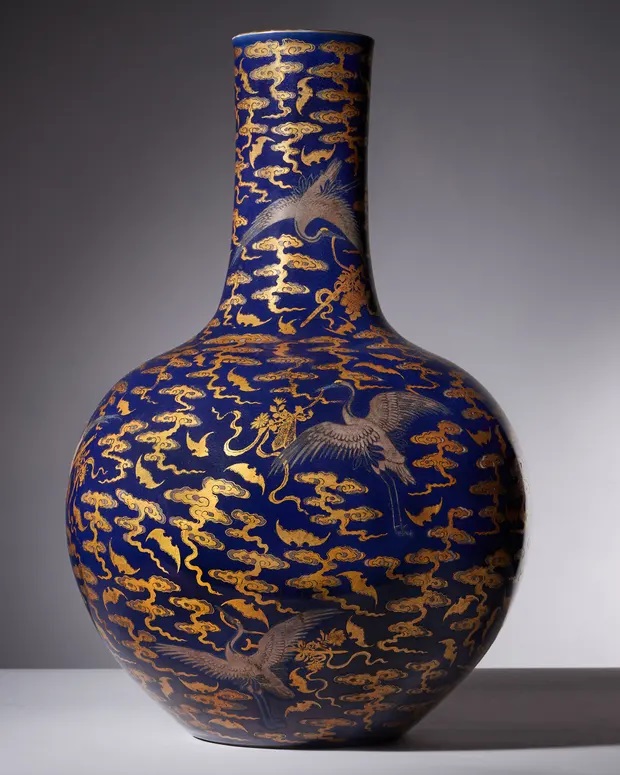
18 May 2022
An extremely rare 18th-century Chinese vase bought by a surgeon in England for a few hundred pounds in the 1980s has sold at auction for almost £1.5m. The 60cm (2 ft) blue-glazed, silver and gilt vase, decorated with cranes and bats, was created for the court of the Qianlong Emperor in the 1700s.
Bought by the owner's late father for its looks, the vase sat in the kitchen of the family's Midlands home, where it was spotted in the 1990s by antiques expert Mark Newstead during a social visit. Years later, Newstead identified the Chinese emperor Qianlong's six-character seal mark on its base, and said the vase was likely displayed in the halls of the Qing palace in the mid-18th century.
Berkshire-based auctioneers Dreweatts had estimated its value at between £100,000-£150,000, but on Wednesday the piece fetched £1.2m, with a buyer's premium bringing the total closer to £1.5m. It was reportedly sold to an international buyer via telephone.
Newstead, who is a specialist consultant in Asian ceramic art at Dreweatts, said: "I was at the house with my wife for lunch in the 1990s. I was surprised to see the vase in the kitchen and said, 'I think that's something rather good,' but didn't pick it up or inspect it, as that wouldn't have been appropriate. "The surgeon bought it just as a decorative thing. We do not have a receipt, but the daughter is reasonably certain he bought it sometime between 1988 and 1993. We are delighted with the result. It shows the demand for the finest porcelain produced in the world."
The vase, which has a crack in its neck, was described as a testament to the creativity of craftspeople working during the Qianlong period, who used enamelling techniques to cater to the emperor's taste in exotic styles. It would have required at least three firings in the kiln to achieve the different colours, including at over 1,200C for the cobalt blue.
> Rare Chinese vase kept in kitchen
28 December 2020
The frescoed thermopolium, a Roman-era fast-food stall, would have served hot food and drinks to locals in the city. The ornate snack bar is in an exceptional state of preservation and is the first to be fully excavated.
The shop, with its bright frescoes and terracotta jars, was discovered in 2019 and unveiled on Saturday. The thermopolium of Regio V is on what was a busy intersection of Silver Wedding Street and Alley of Balconies. A fresco bearing an image of a Nereid nymph riding a seahorse and gladiators in combat had been unearthed previously.
The paintings found at the site are believed to show some of the food that was on offer to customers. Scientists were also able to glean precious new information on gastronomic habits in the town. Chicken and duck, traces of pork, fish, snails and beef were all discovered in jars and other containers for serving with wine or hot beverages. Some of the ingredients had been cooked together rather than prepared separately as a Roman-era paella. Crushed fava beans, used to modify the taste of wine, were found at the bottom of one jar.
"As well as bearing witness to daily life in Pompeii, the possibilities to analyse afforded by this thermopolium are exceptional because for the first time we have excavated a site in its entirety," said Massimo Osanna, director general at the Archaeological Park of Pompeii.
Amphorae, a water tower and a fountain were also found alongside human remains, including those of a man believed to have been about 50 and discovered near a child's bed. "The counter seems to have been closed in a hurry and abandoned by its owners but it is possible that someone, perhaps the oldest man, stayed behind and perished during the first phase of the eruption," Osanna told Ansa news agency. The remains of another person may be those either of an opportunist thief or someone fleeing the eruption who was "surprised by the burning vapours just as he had his hand on the lid of the pot that he had just opened", added Osanna.
The thermopolium - the word comes from the Greek "thermos" for hot and "poleo" to sell - was very popular in the Roman world. Pompeii alone had around 80.
It is hoped the new discovery will open to the public next year.

15 November 2020
A mosiac area unearthed during the excavations conducted by the Osmaniye Museum Directorate in the southern province of Osmaniye's Kadirli district in Turkey has proved a rival to the ancient city of Zeugma with its awe-striking features. A mosaic with a female figure, which archaeologists call "Mona Lisa of the ancient age", attracts attention with its stance, look and similarity to the world-famous Mona Lisa painting. The mosaic area is believed to have once decorated the floor of a villa between the first and the second centuries, and the female figure is thought to have been the owner of the villa.
"We can call this mosaic the Mona Lisa of Kadirli," said archaeologist Umit Kayisoglu. "This mosaic area is the only known mosaic area with human figures in Osmaniye. This is the remains of a villa built in the first and second centuries A.D."
Describing the mosaics found, he said: "There are four different types of mosaics. There is a lady in the middle of one of the mosaics, and we call this person Kadirli's Mona Lisa, because her look and stance are reminiscent of the original one."

15 November 2020
A Roman villa has been found near Wrexham - the first of its kind in north east Wales.
Metal detectorists found Roman material at the site, sparking a remote sensing survey by archaeologists who have found evidence of a buried structure. The remains, in a field in Rossett, include stone and tile buildings around a central courtyard. Artefacts have been found from the late 1st Century and early 4th Century, suggesting the villa was occupied for the majority of Roman rule in Britain.
Dr Caroline Pudney, Senior Lecturer in Archaeology at the University of Chester which was involved in the survey, said: "This exciting discovery potentially alters our understanding of north east Wales in the wake of the Roman conquest. "Previous interpretations suggest that most people in this area either lived in settlements associated with Roman military sites or in quite simple farmsteads that continued to utilise Iron Age roundhouse architectural forms. "The identification of the villa now questions this narrative."
The university and Wrexham museum now plan to continue investigating the site over the next few years.

15 November 2020
1 Dec 2020, starting at 11:00 GMT.
London, New Bond Street.

15 October 2020
If you lived in Ancient Rome you wouldn't be cleaning your teeth with minty toothpaste, instead you'd have used a gruesome concoction of powdered mouse brains. And if you were very very bad, the Romans loved to smother their criminals in honey.
Celebrate Halloween this year with a really revolting trail around our Roman Museum, where you will learn all about the rotten aspects of Roman life. When you finish you will be rewarded with a special treat as you leave! You can also take part in an archaeological dig where you can find some truly terrible treasure.
Date: Sat 22 October 2016 to Sun 30 October 2016 (All day)
Location: Canterbury Roman Museum, 11A Butchery Lane, Canterbury, CT1 2JR, 01227 862162. £1 per child for the trail in addition to museum entry fee. Children must be accompanied by a parent or carer (Kids go free with paying adults)
> A Revolting Roman Halloween
14 October 2020
An ancient gold earring which can be seen depicted in some of the so called Fayum Mummy Portraits from Roman Egypt has been discovered in Southeast Bulgaria by archaeologists excavating the Ancient Roman colony Deultum near the town of Debelt, Burgas District, close to the Black Sea coast.
Deultum was a Roman colony, which according to Roman law signified a status equal to that of the city of Rome itself. In today's Bulgaria, there are only three Roman cities which enjoyed this status - Deultum (Colonia Flavia Pacis Deultensium) near Burgas, Ratiaria (Colonia Ulpia Traiana Ratiaria) near Archar, Ulpia Oescus near Gigen.
Fayum mummy portraits are portraits on wooden boards which were attached to the mummies of upper class residents buried in Egypt during the Roman Era, in the 1st century BC - 3rd AD. Such mummy portraits have been discovered throughout Egypt but most famously in the Fayum Basin, in Hawara and the Roman city of Antinoopolis from the time of Emperor Hadrian (117 - 138 AD). The term "Fayum mummy portraits" is used both as a geographic and stylistic description.
The Roman gold earring discovered in the city of Deultum in Southeast Bulgaria has been found to appear exactly the same as earrings of women depicted in some of the Fayum mummy portraits. Based on that similarity, the earring is dated by the Bulgarian researchers to the 2nd century AD.
The Ancient Roman city of Deultum (Colonia Flavia Pacis Deultensium) was built in the 1st century AD near a previously existing Ancient Thracian settlement called Debelt or Develt. It was settled by Roman military veterans from the Augustus Eight Legion (Legio VIII Augusta) near the Mandra Lake (today the Mandra Water Reservoir) where it also had a port connecting it to the Black Sea
> Roman Woman's Trendy Earring Unearthed in Bulgaria
6 October 2020
In this episode, Neil MacGregor explores how many of the great religions, less than 2000 years ago, began creating sophisticated new images to aid prayer and focus devotion. Many of the artistic conventions created then are still with us. In this programme Neil MacGregor introduces us to one of the earliest known images of the face of Christ. This life sized face is part of a much bigger mosaic. It was made somewhere around the year 350 and was found not in a church but on the floor of a Roman villa in Dorset. What does this astonishing survival say about the state of Christianity at this time and what sort of Christ was imagined in Roman Britain? The historians Dame Averil Cameron and Eamon Duffy help paint the picture.
> Hinton St Mary Mosaic - The Rise of World Faiths (200 - 600 AD)
18 September 2020
An Anglo-Saxon cemetery that may date to the sixth century A.D has been found at a site slated for residential development in the East of England, within the border of the Kingdom of the East Angles.
Brooches, pottery, small iron knives, wrist clasps, amber and glass beads, and silver pennies were uncovered among the more than 200 burials.
The fragile artifacts were removed in blocks of soil for micro-excavation at Norfolk Museum Service.
>Oulton burial site: Sutton Hoo-era Anglo-Saxon cemetery discovered
28 August 2020
Can the history of a field affect the crops that grow in it today? The answer is yes.
In this programme, the historian, Dr Eleanor Rosamund Barraclough, visits a farm in Oxfordshire looking for secrets buried beneath the soil. She speaks to archaeologists and farmers about the impact historical human activity can have on today's crops; from raised phosphate levels on the site of a Roman villa, to increased lead along an old track.
She learns how the past can be used to inform the future of farming.
> Secrets Beneath the Soil
22 August 2020
A Roman game piece and other artifacts were uncovered in an area slated for redevelopment in the walled city of Chester, which was founded as a Roman fort in A.D. 79. The bone game piece is lozenge-shaped and engraved with a ring and dot motif. It is thought to have been used to play Ludus Latrunculorum, the Game of Mercenaries, a two-player military strategy board game. Other artifacts recovered at the site include a possible bone comb, a possible spearhead, and a pin or brooch.
> First Archaeological finds revealed from Chester Northgate site including a gaming piece
8 August 2020
Glass was highly valued across the Roman Empire, particularly a colorless, transparent version that resembled rock crystal. But the source of this coveted material - known as Alexandrian glass - has long remained a mystery. Now, by studying trace quantities of the element hafnium within the glass, researchers have shown that this prized commodity really did originate in ancient Egypt.
It was during the time of the Roman Empire that drinks and food were served in glass vessels for the first time on a large scale, said Patrick Degryse, an archaeometrist at KU Leuven in Belgium, who was not involved in the new study. "It was on every table," he said. Glass was also used in windows and mosaics.
All that glass had to come from somewhere. Between the first and ninth centuries A.D., Roman glassmakers in coastal regions of Egypt and the Levant filled furnaces with sand. The enormous slabs of glass they created tipped the scales at up to nearly 20 tons. That glass was then broken up and distributed to glass workshops, where it was remelted and shaped into final products.
But what many people really wanted was colorless glass, so glassmakers experimented with adding different elements to their batches. Producers in the Levant are known to have added manganese, which reacts with iron impurities in sand. The manganese-treated glass still retained a bit of color, however, said Gry Hoffmann Barfod, a geoscientist at Aarhus University in Denmark who led the study, which was published this month in Scientific Reports. "It wasn't perfect," she said. Glassmakers also tried adding antimony, with much better results. "That made it completely crystal clear," Dr. Barfod said.
And expensive: A price list issued by the Roman emperor Diocletian in the early fourth century A.D. refers to this colorless glass as 'Alexandrian' and values it at nearly double the price of manganese-treated glass. But the provenance of Alexandrian glass, despite its name, had never been conclusively pinned to Egypt.
"We have the factories for manganese-decolorized glass, but we don't have them for the Alexandrian glass," Dr. Barfod said. "It's been a mystery that historians have dreamed of solving."
Glass forged in different geographic regions had different hafnium signatures, Dr. Barfod and her collaborators showed. Egyptian glass consistently contained more of the chemical hafnium and had lower isotopic ratios than glass produced in the Levant, the team found.
After being expelled from the mouth of the Nile, sand sweeps east and north up the coast of the Levant, propelled by water currents. The zircon crystals within it are heavy, so they tend to settle out early in the journey on Egyptian beaches. That explains why glass forged in Egyptian furnaces tends to contain more hafnium than Levantine glass, the researchers suggest.
> The Romans Called it 'Alexandrian Glass.' Where Was It Really From?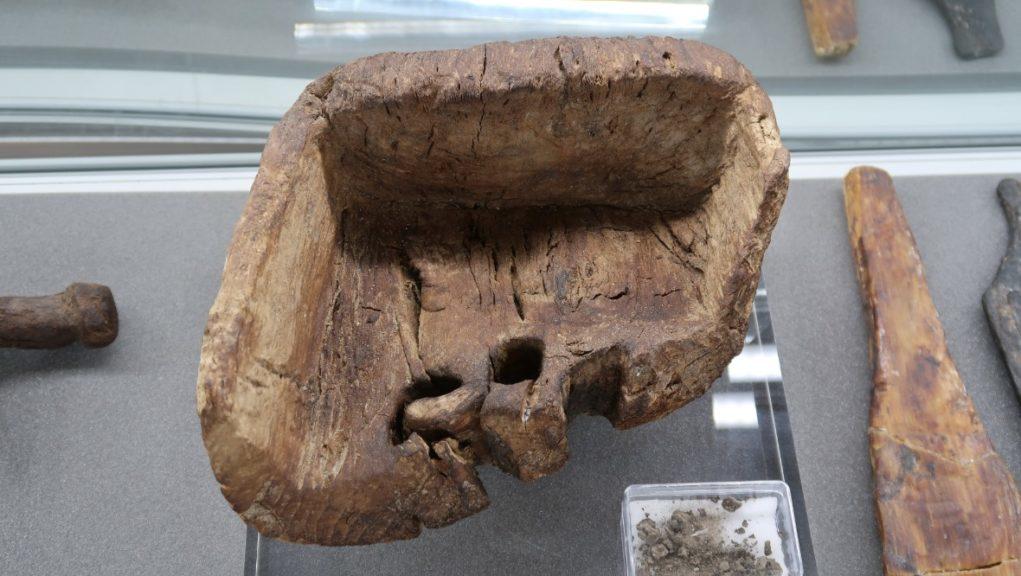
24 July 2020
Traces of dairy matter were found preserved inside a wooden butter dish, made by an Iron Age community. The wooden dish was discovered by archaeologists at the bottom of Loch Tay, where at least 17 crannogs, or Iron Age wooden houses, once stood. Built from alder with a lifespan of around 20 years, the structures simply collapsed into the loch once they had served their purpose, taking the objects inside with them.
Rich Hiden, archaeologist at the Scottish Crannog Centre, said conditions at the bottom of the loch had offered the perfect environment to preserve the butter and the dish. When they started excavating, they pulled out this square wooden dish, which had chisel marks on the sides as well as grey matter.
Analysis of the matter found it was dairy material, with experts believing it likely originated from a cow. Holes in the bottom of the wooden dish suggest it was used for the buttering process. The butter then may have been turned into cheese by adding rennet, which naturally forms in a number of plants, including nettles.
> Butter dating back 2500 years found at the bottom of Scottish loch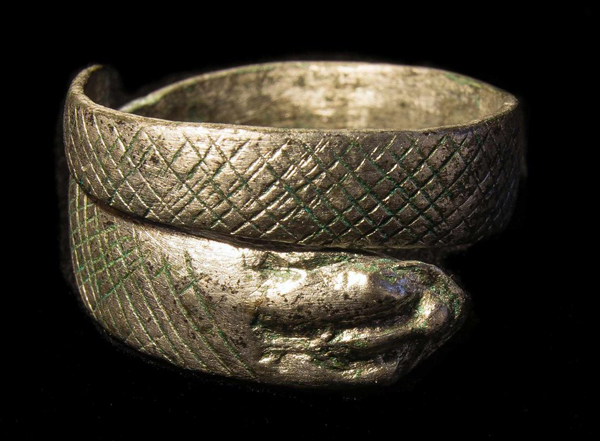
17 July 2020
Ancient shoes, a rare silver ring, a plumb bob used to build straight roads and a never found before elaborately carved amber figurine are among thousands of objects found in North Yorkshire which are teaching us more about Roman Britain.
Excavations carried out as part of works to upgrade the A1 have revealed a major settlement at Scotch Corner, North Yorkshire and suggests the Romans came to northern England earlier than previously thought.
> New Discoveries Shed Light on Romans in Northern England
14 July 2020
The British public have discovered hundreds of thousands of archaeological objects, and the British Museum has revealed that the number recorded by its Portable Antiquities Scheme has hit a milestone 1.5m. These finds have radically transformed what we know about life through time on the British Isles.
> Treasures found by the British public - in pictures
20 June 2020
Archaeologists have discovered a ring of prehistoric shafts, dug thousands of years ago near Stonehenge. Fieldwork has revealed evidence of a 1.2 mile (2km) wide circle of large shafts measuring more than 10m in diameter and 5m in depth. They surround the ancient settlement of Durrington Walls, two miles (3km) from Stonehenge. Tests suggest the ground works are Neolithic and were excavated more than 4,500 years ago. Experts believe the 20 or more shafts may have served as a boundary to a sacred area connected to the henge.
The announcement of the discovery comes after the Summer Solstice, which took place online this year as the annual gathering at Stonehenge was cancelled due to coronavirus.
> Stonehenge: Neolithic monument found near sacred site
14 June 2020
Roman forts, roads, military camps and villas have been identified by a new analysis of aerial photographs taken in the 2018 heatwave across Wales. Scorched crop In Monmouthshire, the researchers have identified a new "marching camp" at a site near Caerwent. They were the temporary overnight stops that the Romans built on manoeuvres in hostile territory. The site would have provided defensive positions, camping and kitchens for bread ovens. This is when Wales was a very dangerous place to be for the troops as they were still under attack. The entire area heading into south-east Wales through Usk to Caerleon would have been peppered with similar sites, believe the experts, as the Roman armies fought a 20-year battle to crush resistance amongst Celtic tribes, notably the Silures in southern Wales. With conquest came reinforcements, and that meant forts. The aerial photographs confirmed the locations of at least three new fort sites, including the first found in the Vale of Gwent at Carrow Hill, west of the Roman town of Caerwent and the Roman legionary fortress at Caerleon. The crop images show it had inner and outer defensive structure and a "killing zone" in between, perfectly ranged for a javelin throw. The photographs found a long suspected fort site at Aberllynfi near Hay-on-Wye is indeed Roman, even though part of it has long since been built over by housing. While further investigations at Pen y Gaer in Powys, near Tretower and Crickhowell, have revealed new detailed structures previously undiscovered - despite digs and surveys on the ground. The researchers have also been able to identify details of new villas - including at St Arvans, north of Chepstow in Monmouthshire. The location had previously been considered a temple site, after part of a bronze statue of Mars was unearthed. But the heatwave images make it clear this was a Roman villa of some note, with its room structure clearly visible. Perhaps the most startling discoveries have been pieces of unknown Roman road. One shows how the Roman armies pushed their way south from Carmarthen to Kidwelly, reinforcing speculation the town was home to a Roman fort - even if it may now be covered by Kidwelly Castle.

27 February 2020
A Roman ring might have been made by the same jeweller behind a famous hoard.
The silver ring, featuring two snake heads, was found in Buckinghamshire by a detectorist from Essex. Items with the same distinctive cobra heads were part of the Snettisham Jeweller's Hoard found in Norfolk in 1985. The Snettisham hoard, thought to be from the stock of a single jeweller, was buried in a pot in about AD155 and rediscovered during building work.
The ring, unearthed at Upper Winchendon near Aylesbury, has been bent, so experts can't be sure about its original design. However, the Snettisham hoard had pieces in it with this type of snake head, so it's possible it came from the same workshop but, as it was found in a field with no archaeological context, experts cannot be certain.
In her book, The Jewellery of Roman Britain, Catherine Johns said it was thought snake-motif jewellery was worn as an amulet because in the classical world snakes were positive symbols - associated with healing, rebirth and ancestors.
The find was described as quite unusual because of the two snake heads, and because we don't have many examples of this kind of ring in the British Museum's Portable Antiquities Scheme database. The silver ring would have belonged to someone with access to a fair amount of money, whereas less valuable versions were made of copper-alloy (bronze).
The ring, found in March 2018, was declared treasure at Buckinghamshire Coroner's Court. A museum has expressed an interest in buying the ring and is waiting for the Treasure Valuation Committee's verdict on the price.
> Roman snake ring found in Buckinghamshire declared treasure
15 February 2020
A Roman villa unearthed during building work will be preserved after developers agreed to "re-plan" the estate.
More than 6,000 people signed a petition to save the remains discovered by archaeologists working on behalf of Bovis Homes in Cam, Gloucestershire. The firm said experts had told them the remains did not qualify for preservation but it had since "found a compromise".
Bovis Homes said it would change its plans "so that there will be no homes or hard-standing on the ground above the site of the villa's remains". Nigel Lush, from the company, said: "Everyone has come at this challenge with a commitment to work together to try and find a practical solution. "In terms of the villa's preservation and the public's health and safety, leaving the remains exposed to the elements was not a feasible option but we believe we have found a compromise that allows the community to enjoy the villa and find out more about Cam's history." He said the plans included turning the land above the structure into a public space, with information boards and a virtual tour outlining what was discovered beneath the ground.
BBC TV presenter and archaeology expert Professor Mark Horton was among those who called for the villa to be saved, describing it as "a very important discovery".
Campaigner Christie McLean, who started the petition to save the villa, said: "I think it's fantastic. They've [Bovis Homes] joined the community spirit and they've made changes in accordance with what the locals would like."
> Developers will protect Roman villa unearthed in Cam
29 January 2020
A pensioner has uncovered an amulet of a dog in his garage worth a staggering £3 million.
When Alfred Correya, 66, found the tiny jade jewel in a chest of drawers, he had no idea of its value.
But he has since learned it is between 4,000 and 5, 000 years old, with experts saying they can trace it back to Stone Age China.
Mr Correya's father was an Indian gem dealer and emigrated to Britain in the 1960s. When he died aged 96 in 2002, the amulet was left in his son's garage and forgotten. Mr Correya said: "My dad acquired all sorts of pieces but this dog was seen as a trinket. He seems to have been somewhat mistaken."
Asian art expert Alexander Clement confirmed the amulet's age and valued it at between £2 million and £3 million.
> Found in a garage, the tiny amulet worth £3m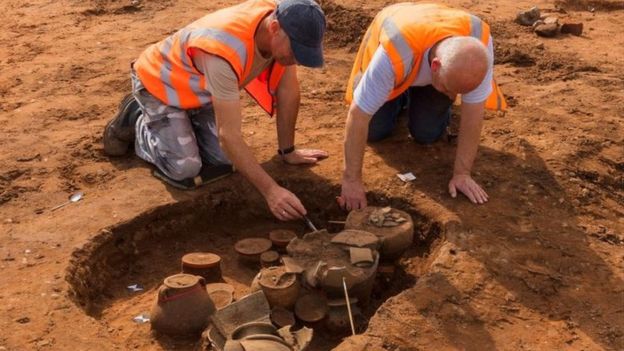
29 January 2020
Pots, jugs and jewellery were found in Baginton, next to Lunt Roman Fort and Coventry Airport in Warwickshire. The pieces were found during a dig ahead of a housing development project in summer 2017 but many of the items have only just been officially dated and verified by experts.
Senior archaeologist Nigel Page, from Warwickshire County Council which led the dig, said it was a "remarkable" find. "It's a significant discovery in the West Midlands," he said. "There was a real buzz of excitement when the site was found, it's breathtaking."
Archaeologists believe two of the graves contained a "high status" ranking officer and a Roman girl, aged between six and 12. A decorative brooch was found within a Roman cremation burial site of a young girl. It was one of four brooches from a small pile of jewellery placed in the grave and covered by a polished mirror. Other jewellery included a ring, with an image of a cicada - an insect associated with immortality - and a hair pin. Experts said the items and imagery on some of the jewellery suggested a link to southern Europe.
A dozen Anglo-Saxon graves were also excavated, some of which contained goods including a Frankish vessel from the northern France and Belgium area.
"The presence of the Frankish vessel suggests that, just as during the Roman period, goods and people were moving into and through the area from a wide area, including from Europe," Mr Page said. One burial contained the centre of a shield, fragments of a knife blade in its leather sheath and a crushed copper alloy hanging bowl. Experts said the richness of the Anglo-Saxon grave suggested a person of reasonably high status, such as a high ranking officer.
The settlement at Baginton continued to flourish after the Romans left in the early 5th Century AD.
> Roman and Anglo-Saxon artefacts found in Baginton
8 January 2020
The resting places of more than 50 adults and children have been found in an unusual Roman cemetery unearthed during building work for a new school in Somerset. Archaeologists say the discovery at Somerton, near Glastonbury, sheds significant light on life and death in the south-west of Britain after the Roman invasion.
Some of the people buried in the Romano-British cemetery were clearly of high status, with the position of one woman's skull indicating her head was initially resting on a pillow. Tiny nails were also found at the foot of the graves, suggesting most of the people were buried wearing hobnail boots. Human remains and a cooking pot were also discovered during building work for a new school.
But it is the structure of the graves that is fascinating. The majority were lined with local stone and capped and sealed with the same sort of slabs used to create roofs in the area 2,000 years ago. In one particularly unusual grave, slabs were used to create a tent-like structure above the person who was buried. A similar setup was recently discovered at the Hinkley Point C nuclear power station construction site on the Somerset coast 25 miles (40km) north-west of Somerton and it has echoes of grave profiles in Spain and Italy.
Other finds include grave goods such as pottery and jewellery, while one pot that was dug up contained a chicken wing. A coin from the time of Emperor Vespasian, who ruled from AD69 to AD79, and a piece of carved bone, most likely from a knife handle, were also uncovered.
> Archaeologists find graves of high status Romans in Somerset
18 December 2019
Archaeologists from the University of Cincinnati have discovered two royal tombs in Greece containing engraved jewellery and artefacts dating back more than 3,000 years. The finds include a gold ring depicting bulls flanked by sheaves of barley and a gold pendant featuring the likeness of the Egyptian goddess Hathor.
The US researchers say their discovery will provide new clues about early Mycenaean trade and culture. The tombs are near the Bronze Age palace of Pylos, in Greece's southern Peloponnese region.
Jack Davis and Sharon Stocker, archaeologists in UC's classics department, found the two beehive-shaped tombs while investigating the area around the grave of an individual they have called the "Griffin Warrior," a Greek man whose final resting place they discovered nearby in 2015.
Like the Griffin Warrior's tomb, the princely tombs overlooking the Mediterranean Sea also contained a wealth of cultural artefacts and delicate jewelry that could help historians fill in gaps in our knowledge of early Greek civilization.
Jack Davis said items such as the gold ring depicting two bulls with sheaves of barley gave an insight into life around the Mediterranean more than 3,000 years ago. "It's an interesting scene of animal husbandry - cattle mixed with grain production. It's the foundation of agriculture," he said.
The tombs were littered with tiny pieces of gold leaf that had fallen from the walls.
> Archaeologists find Bronze Age tombs lined with gold
10 December 2019
Whilst studying archaeology at university, I was fascinated by the mysterious stone balls found at sites all over Orkney. These new objects, whilst not as aesthetically pleasing, add further to the mystery of the people who lived on Orkney lithic and early Bronze Age.
Archaeologists working at the site of a proposed electricity sub-station in Orkney have found nine "amazing" stone carvings. The 50cm (20in) tall sculptures have all been worked to give them shoulders, a neck and what looks like a head. The first has been nicknamed the "Finstown Fella", after the location of the dig. After it was recognised, eight more were found on the site. Experts believe they date from roughly 2000BC.
Sean Bell, site director for ORCA Archaeology, told BBC Radio Orkney that they had all been worked using a technique known as pecking - chipping away flakes of stone with a pointed metal or stone tool. He said the round shape on the largest of the carved stones "definitely looks like a head, and in some lights you think you can see features on it. But whether that's intentional or not, we can't say." Mr Bell said finding nine of the anthropomorphic - or human like - stones in one place is unprecedented. "Examples have come up, usually as individuals as a result of people ploughing," he added.t some of the examples we've got, instead of being rotund and three dimensional, are very flat. And they're similar to some that have come out from the Links of Noltland (on the island of Westray). "So, even though we're calling them all necked stones, they might not all have the same function, but so little is known about them. That's why this is so important."
The objects could be deliberate representations of the human form. Or they might have been made for a specific practical purpose, or, perhaps both. "One theory, particularly with the flat ones, is they may be set in the ground, and then the neck is used for a tether. A sort of Neolithic tent peg," Mr Bell said. "Of course when you talk about anthropomorphic figures, you automatically start thinking of ritual and religion. "But even a flat one being used to tether something could still be part of that aspect of society."
Sean Bell said the discovery of so many of the stones in one place, and in a secure archaeological context, shines a light on a relatively unknown part of Orcadian pre-history and may help experts to understand more about the objects.
The dig was carried out at Finstown ahead of development at the site by SSEN Transmission.
> Nine 'amazing' Bronze Age figurines found at Orkney dig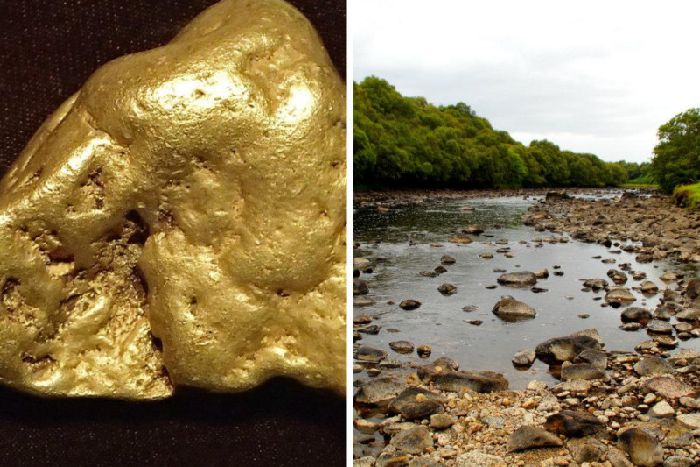
4 December 2019
A lump of pure gold, which weighs 121.3g (4.2 oz), was unearthed in a mystery location in May this year. The two pieces form a doughnut shape and could be worth £80,000. The previous largest find, in 2016, was the 85.7g (3oz) Douglas Nugget. However, gold panning experts are remaining sceptical until its provenance can be confirmed. The treasure was discovered in two pieces but fits together perfectly, earning it the name The Reunion Nugget. The gold-panning community is renowned for its secrecy, and the name of the river where it was found has not been revealed. The lucky finder is also remaining anonymous.
The finder brought the discovery to the attention of author Lee Palmer who was researching his book Gold Occurrences In The UK. Mr Palmer, 50, said: "This is now the largest nugget in existence in the UK. When you look at it, it's doughnut-shaped. "There are no impurities in it, it is just pure gold nugget of about 22 carats. It really is a remarkable find." The nugget was found using the method of "sniping", which sees gold hunters lying face down in a river while wearing a snorkel and dry suit. The enthusiast unearthed the larger piece first, which weighs 89.6g (3.1oz), before finding the other half, weighing 31.7g (1,1oz) 10 minutes later. Mr Palmer said: "The man just threw the bigger piece in his bucket with the rest of his stuff - he knew it was big but didn't realise how big. "He found the second nugget 30cm (12in) away and chucked that in his bucket too. "It wasn't until a couple of days later that he had a look at them and realised how big they were and that they fitted together." He added: "The hole in the middle could have been caused by a strike off a rock or glacier. "One mineralogist thought it looked like an entry and exit hole that could've been made with a neolithic antler pick, which were used by farmers in the Iron Age."
Both the finder of the nugget and the owner of the land where it was discovered are keeping their identities secret due to its magnitude. Mr Palmer hopes it will be purchased by either the National Museum Of Scotland or the Natural History Museum, but legally it may have to be handed over to The Crown Estate. He believes the fact it is in two pieces should not affect its value. Mr Palmer said: "From the top you could say it looks like two bits, but when you see it from underneath, it's a perfect fit. "It's like an exact jigsaw, there's no disputing it. "Even if you took the largest individual piece, it is still the biggest one in the UK. "Add together the second piece and the story behind it and you've got something amazing." The Douglas Nugget holds the current record for the largest gold nugget found in the UK for 500 years.
> UK's 'largest' gold nugget discovered in Scottish river
29 November 2019
A recent study looked at the evidence for the use of ancient vessels to feed animal milk to prehistoric babies. There are a variety of ancient glass and ceramic vessels with small, thin spouts that have tested scholars as to their function. It seems likely that the majority of the prehistoric clay and later Roman glass vessels were used to feed infants or the infirm, while the ceramic Greek and Roman forms were used to replenish oil lamps or for other domestic uses.
A team of scientists, led by the University of Bristol, found the first evidence that prehistoric babies were fed animal milk using the equivalent of modern-day baby bottles.
Possible infant feeding vessels, made from clay, first appear in Europe in the Neolithic (at around 5,000 BC), becoming more commonplace throughout the Bronze and Iron Ages. The vessels are usually small enough to fit within a baby's hands and have a spout through which liquid could be suckled. Sometimes they have feet and are shaped like imaginary animals. Despite this, in the lack of any direct evidence for their function, it has been suggested they may also be feeding vessels for the sick or infirm.
The researchers wanted to investigate whether these were in fact infant feeding vessels (baby bottles) so selected three examples found in very rare child graves in Bavaria. These were small (about 5 - 10 cm across) with an extremely narrow spout. The team used a combined chemical and isotopic approach to identify and quantify the food residues found within the vessels. Their findings, published in the journal Nature, showed that the bottles contained ruminant milk from domesticated cattle, sheep or goat. The presence of these three obviously specialised vessels in child graves combined with the chemical evidence confirms that these vessels were used to feed animal milk to babies either in the place of human milk and/or during weaning onto supplementary foods.
This is the first study that has applied this direct method of identification of weaning foods to infants in the past and opens the way for investigations of feeding vessels from other ancient cultures worldwide. Lead author, Dr Julie Dunne from the University of Bristol's School of Chemistry, said: "These very small, evocative, vessels give us valuable information on how and what babies were fed thousands of years ago, providing a real connection to mothers and infants in the past." She continued: "Similar vessels do appear in other cultures (such as Rome and ancient Greece) across the world. Ideally, we'd like to carry out a larger geographic study and investigate whether they served the same purpose."
Project partner, Dr Katharina Rebay-Salisbury from the Institute for Oriental and European Archaeology of the Austrian Academy of Sciences, who directs an ERC-funded project on motherhood in prehistory, added: "Bringing up babies in prehistory was not an easy task. We are interested in researching cultural practices of mothering, which had profound implications for the survival of babies. It is fascinating to be able to see, for the first time, which foods these vessels contained."
Professor Richard Evershed FRS who heads up Bristol's Organic Geochemistry Unit and is a co-author of the study, added: "This is a striking example of how robust biomolecular information, properly integrated with the archaeology of these objects, has provided a fascinating insight into an aspect of prehistoric human life so familiar to us today."

26 November 2019
If you've ever dreamt of discovering a roman mosaic (and who hasn't) then this new book is the next best thing.
The Boxford Mosaic - tells the story behind finding one of the most spectacular Roman mosaics in Britain.
Dating from around 350AD, this mosaic is one of just three of its kind in the world - a masterpiece of Roman artistry and a beautifully preserved link to the past. It lay hidden beneath a Berkshire field in the sleepy village of Boxford for some 1,600 years until it was fully uncovered in the summer of 2019.
The book tells the story of how the mosaic came to be discovered, the painstaking process of uncovering it, and the myths depicted within it.
Some of the most famous heroes from Greek mythology are brought to life in the stunning artwork. Hercules slays the half-man, half-horse Centaur. Pelops wins the hand of a king's daughter by sabotaging his racing chariot. The handsome Bellerophon kills the fire-breathing Chimaera monster with the help of his flying horse Pegasus and a lance tipped with lead. This legend spread down the centuries into the folklore of many countries; in Britain it became St George and the Dragon.
The full description of this artistic masterpiece and its excavation, by local enthusiasts working under professional supervision, is told by the people who played key roles in the excavation.
80 pages in full colour. Authors: Anthony Beeson, Matt Nichol & Joy Appleton. ISBN 9781846743924
> The Boxford Mosaic
25 November 2019
A leading archaeologist is calling for Christie's to cancel the auction of a first-century Roman statue because of its alleged links to notorious dealers connected with numerous cases of illicit antiquities. Prof Christos Tsirogiannis claims relate to a marble depiction of Eros unstringing his bow, which is due to be sold on 4 December. Estimated to fetch between £500,000 and £800,000, the 94cm statue is given pride of place on the catalogue's cover. However, Tsirogiannis says he has four photographs of exactly the same object in the possession of the disgraced dealer Robin Symes and his late partner Christo Michaelides, whose archives were seized by police and held by authorities in Greece and Italy. Tsirogiannis described the phrase said to be as "unacceptable and showed that the provenance was uncertain. Christie's should withdraw the piece and contact the authorities [who will] tell them what to do." He said this case was the latest example of a major auctioneer failing to make adequate checks with the authorities.
Tsirogiannis, a former senior field archaeologist at Cambridge University's archaeological unit, was recently appointed associate professor at the Institute of Advanced Studies, University of Aarhus, in Denmark. Greek and Italian authorities gave him official access to confiscated archival material as his academic research has focused on antiquities and trafficking networks. Over 13 years, he has identified about 1,100 looted artefacts within auction houses, commercial galleries and private collections. Notifying Interpol and other police authorities, he has played a major role in securing the repatriation of many antiquities to their country of origin. His research is based on tens of thousands of images and other archival material seized on police raids from individuals involved in the illicit trade. That material includes the business dealings of Giacomo Medici, convicted in Italy in 2004 of dealing in stolen artefacts, and Gianfranco Becchina, convicted in Italy in 2011 of illegally dealing in antiquities.
> Christie's urged to pull sale of Roman statue 'linked to illicit dealers'
© Minerva Ancients 2024 All rights reserved
Powered by w3.css